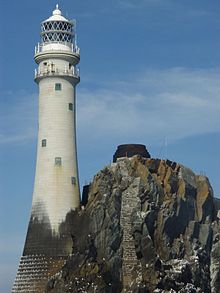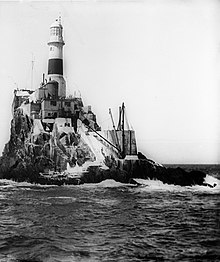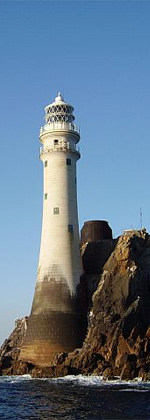Lighthouse
 The second lighthouse on Fastnet Rock. The lower portion of the first lighthouse is also visible at right. The second lighthouse on Fastnet Rock. The lower portion of the first lighthouse is also visible at right. | |
| Location | Fastnet Rock, County Cork, Ireland |
|---|---|
| Coordinates | 51°23′16″N 9°36′11″W / 51.38778°N 9.60306°W / 51.38778; -9.60306 |
| Tower | |
| Constructed | 1897 |
| Designed by | William Douglass |
| Construction | granite |
| Automated | 1989 |
| Height | 54 m (177 ft) |
| Shape | Tapered cylindrical tower with lantern and double gallery |
| Markings | white |
| Operator | Commissioners of Irish Lights |
| Racon | G |
| Light | |
| First lit | 27 June 1904 |
| Focal height | 49 m (161 ft) |
| Lens | first order Fresnel lens |
| Intensity | 2,500,000 candela |
| Range | 27 nmi (50 km; 31 mi) |
| Characteristic | |
| Ireland no. | CIL-0010 |
| Original lighthouse | |
 | |
| Constructed | 1854 |
| Designed by | George Halpin |
| Construction | cast iron, brick |
| Height | 91 ft (28 m) |
| First lit | 1 January 1854 |
| Intensity | 38 kilocandela |
Fastnet Lighthouse is a 54-metre-tall (177 ft) lighthouse situated on the remote Fastnet Rock in the Atlantic Ocean. It is the most southerly point of Ireland and lies 6.5 kilometres (4.0 mi) southwest of Cape Clear Island and 13 kilometres (8.1 mi) from County Cork on the Irish mainland. The current lighthouse is the second to be built on the rock and is the tallest in Ireland.
First lighthouse
Construction of the first lighthouse began in 1853, and it first produced a light on 1 January 1854. The lighthouse replaced an early one built on Cape Clear Island in 1818, partly motivated by the loss of an American sailing packet, Stephen Whitney, in thick fog during November 1847 on nearby West Calf Island causing the death of 92 of her 110 passengers and crew. The new lighthouse was constructed of cast iron with an inner lining of brick and was designed by George Halpin. Costing £17,390, the tower was 19.4 metres (63 ft 9 in) tall with an 8.4-metre-tall (27 ft 8 in) lantern structure on top, giving a total height of around 28 metres (91 ft). It had an oil-burning lamp of 38 kilocandelas; in contrast, modern lighthouses typically produce 1,300 kilocandelas. In 1883 an explosive fog signal was installed, which electrically detonated a small charge of guncotton every five minutes.
The tower proved to be too weak since gales shook it to the point that crockery was sometimes thrown off tables, and at one point a 270 L (60 imp gal) cask of water lashed to the gallery 41 metres (133 ft) above high water was washed away. Various steps were taken to strengthen the tower, including fitting a casing around the bottom section up to the second floor and filling it with stone, and the surrounding rock smoothed over. In 1865 the lower floors were filled in with solid material.
Second lighthouse
In 1891 the Commissioners of Irish Lights had resolved that the light was not sufficiently powerful, particularly for the first landfall for many ships crossing the Atlantic. The replacement was constructed of stone, cast iron now being considered unsatisfactory – the whole of the nearby Calf tower above its strengthening casing had been carried away during a gale on 27 November 1881, although without loss of life. On the same day, the sea had broken the glass of the Fastnet Rock lantern.

The new lighthouse was designed by William Douglass and built under the supervision of James Kavanagh. Construction started in 1897 with the levelling of the site, and the first of 2,047 dovetailed blocks of Cornish granite was laid in June 1899. As well as these blocks, weighing 4,400 t (4,300 long tons) in total and with a volume of 1,645.0 cubic metres (58,093 cubic feet), a further 120 cubic metres (4,100 cubic feet) of granite was used to fill the inside of the tower up to the level of the entrance floor, 18 metres (58 ft) above high-water mark. A small steamship, the Ierne, was specially constructed for carrying the blocks out to the island, and Kavanagh personally set every stone, which weighed between 1.8 and 3.0 t (1.75 and 3 long tons). The new lighthouse entered service on 27 June 1904, having cost nearly £90,000.
The masonry tower is 45 metres (146 ft) high, but the focal point of the light is 48 metres (159 ft) above high-water mark. The base of the lighthouse is 16 metres (52 ft) in diameter with the first course of stone 150 millimetres (6 in) below the high-water mark, and the first ten of the 89 courses are built into the rock. The first floor of the original tower remains, on the highest part of the rock, having been left when it was demolished and converted into an oil store.
The fog signal was changed to one report every three minutes in 1934, and from 1965 accompanied by a brilliant flash when operated during darkness. The original vaporised paraffin light was replaced with an electric one on 10 May 1969. At the end of March 1989, the lighthouse was converted to automatic operation. It is monitored and controlled using a UHF telemetry link to Mizen Head Lighthouse in County Cork, and onwards by landline to the Irish Lights control centre at Dún Laoghaire.
It produces a 0.14-second white flash every five seconds, with a nominal range of 27 nautical miles (50 kilometres) and a power of 2,500 kilocandelas. Since April 1978 in addition to being operated during darkness, the light is also used during poor visibility. In 1974 the explosive fog signal was replaced with an electric foghorn producing four blasts every minute at 300 hertz with a nominal range of 3.9 nautical miles (7.2 kilometres). Following a review of navigational aids, the fog signal was permanently shut down on 11 January 2011. The racon (radar transponder beacon) has transmitted the Morse code for the letter G since its installation in 1994.
In 1985, the lighthouse was struck by a rogue wave about 48 metres (157 ft) high.
On 16 October 2017, a wind gust of 191 km/h (119 mph) was recorded at the lighthouse, during Hurricane Ophelia. This is an Irish record, based on measurements going back to the 1860s. The previous record was 181 km/h (112 mph) at Malin Head during Hurricane Debbie in 1961.
Fastnet Rock
"Fastnet Rock" redirects here. For the racehorse, see Fastnet Rock (horse).
Fastnet Rock (Irish: Carraig Aonair, lit. 'Lone Rock') or simply Fastnet (possibly from Old Norse Hvasstein-ey 'sharp-stone isle'), is a small clay-slate islet with quartz veins, and rises to about 30 metres (98 ft) above the low water mark and is separated from the much smaller Little Fastnet to the south by a 10-metre-wide (33 ft) channel. Fastnet is known as "Ireland's Teardrop", because it was the last part of Ireland that some 19th-century Irish emigrants saw as they sailed to North America.
Fastnet also gives its name to the sea area used by the Shipping Forecasts transmitted by the BBC.
Fastnet Rock is used as the midpoint of one of the world's classic offshore yachting races, the Fastnet Race, a 1,126-kilometre (700 mi) round-trip from Cowes on the Isle of Wight, around the rock and back to Plymouth (from 2021 onwards, back to Cherbourg in France). It is also sometimes used as a mark for yacht races from local sailing centres such as Schull, Baltimore, and Crookhaven.
See also
- "Carraig Aonair (The Lone Rock)" folksong about a disaster on the rock.
- List of lighthouses in Ireland
- List of islands of Ireland
References
- "Ireland – Geographical facts and figures". Travel through the Ireland story... Retrieved 15 September 2007.
- ""James Kavanagh and the Fastnet Lighthouse"". Archived from the original on 17 May 2012. Retrieved 5 March 2016.
- "Fastnet Lighthouse". Commissioners of Irish Lights. Retrieved 17 December 2018.
- ^ "The Story of the Fastnet" – The Economist Magazine 18 December 2008
- "Carraig Aonair/Fastnet Rock". logainm.ie. Retrieved 15 January 2023.
- "Foclóir Gaeilge–Béarla (Ó Dónaill): aonar". www.teanglann.ie. Retrieved 11 May 2023.
- Paul Clements (1 June 2015). The Rough Guide to Ireland. Rough Guides Limited. p. 377. ISBN 978-0-241-23620-8.
- "BBC Weather - Shipping Forecast". BBC Weather. Retrieved 4 March 2021.
Sources
- Morrissey, James (2005). A History of Fastnet Lighthouse. Columbia Press. ISBN 978-0-9512826-6-3
- The Fastnet Lighthouse: Light on a lonely rock, The Economist 18 Dec 2008
- C.W. Scott, History of Fastnet Lighthouses, Schull Books 2001
- R. Coates, 'Fastnet', Nomina 20 (1997), pp. 37–46
- Fastnet Lighthouse Vital Statistics Archived 29 April 2010 at the Wayback Machine
- Pictures of the lighthouse
- Mizen Head Signal Station
- 9/28/1907;Fastnet Rock Lighthouses As Seen From Ooean Liners
External links
- Fastnet Rock Commissioners of Irish Lights
- Fastnet Rock Tour from Baltimore and Cape Clear Island
- Fastnet Construction Archived 10 September 2017 at the Wayback Machine
